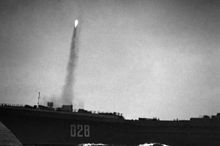Vertical launching system
This article needs additional citations for verification. (January 2017) |

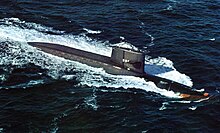

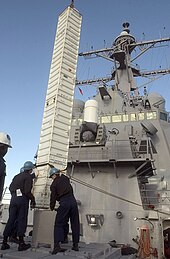
A vertical launching system (VLS) is an advanced system for holding and firing missiles on mobile naval platforms, such as surface ships and submarines. Each vertical launch system consists of a number of cells, which can hold one or more missiles ready for firing. Typically, each cell can hold a number of different types of missiles, allowing the ship flexibility to load the best set for any given mission. Further, when new missiles are developed, they are typically fitted to the existing vertical launch systems of that nation, allowing existing ships to use new types of missiles without expensive rework. When the command is given, the missile flies straight up long enough to clear the cell and the ship, and then turns on course.
A VLS allows surface combatants to have a greater number of weapons ready for firing at any given time compared to older launching systems such as the Mark 13 single-arm and Mark 26 twin-arm launchers, which were fed from behind by a magazine below the main deck. In addition to greater firepower, VLS is much more damage tolerant and reliable than the previous systems, and has a lower radar cross-section (RCS). The U.S. Navy now relies exclusively on VLS for its guided missile destroyers and cruisers.
The most widespread vertical launch system in the world is the Mark 41, developed by the United States Navy. More than 11,000 Mark 41 VLS missile cells have been delivered, or are on order, for use on 186 ships across 19 ship classes, in 11 navies around the world. This system currently serves with the US Navy as well as the Australian, Danish, Dutch, German, Japanese, New Zealand, Norwegian, South Korean, Spanish, and Turkish navies, while others like the Greek Navy preferred the similar Mark 48 system.[1]
The advanced Mark 57 vertical launch system is used on the new Zumwalt-class destroyer. The older Mark 13 and Mark 26 systems remain in service on ships that were sold to other countries such as Taiwan and Poland.
When installed on an SSN (nuclear-powered attack submarine), a VLS allows a greater number and variety of weapons to be deployed, compared with using only torpedo tubes.
Launch type[]
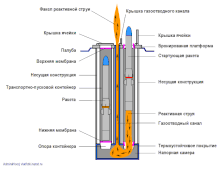

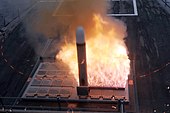
A vertical launch system can be either hot launch, where the missile ignites in the cell, or cold launch, where the missile is expelled by gas produced by a gas generator which is not part of the missile itself, and then the missile ignites. "Cold" means relatively cold compared with rocket engine exhaust. A hot launch system does not require an ejection mechanism, but does require some way of disposing of the missile's exhaust and heat as it leaves the cell. If the missile ignites in a cell without an ejection mechanism, the cell must withstand the tremendous heat generated without igniting the missiles in the adjacent cells.
Hot launch[]
An advantage of a hot-launch system is that the missile propels itself out of the launching cell using its own engine, which eliminates the need for a separate system to eject the missile from the launching tube. This potentially makes a hot-launch system relatively light, small, and economical to develop and produce, particularly when designed around smaller missiles. A potential disadvantage is that a malfunctioning missile could destroy the launch tube. American surface-ship VLSs have the missile cells arranged in a grid with one lid per cell and are "hot launch" systems; the engine ignites within the cell during the launch, and thus it requires exhaust piping for the missile flames and gasses. France, Italy and Britain use a similar hot-launching Sylver system in PAAMS.
Cold launch[]
The advantage of the cold-launch system is in its safety: should a missile engine malfunction during launch, the cold-launch system can eject the missile thereby reducing or eliminating the threat. For this reason, Russian VLSs are often designed with a slant so that a malfunctioning missile will land in the water instead of on the ship's deck. As missile size grows, the benefits of ejection launching increase. Above a certain size, a missile booster cannot be safely ignited within the confines of a ship's hull. Most modern ICBMs and SLBMs are cold-launched. Russia produces both grid systems and a revolver arrangement with more than one missile per lid for its cold launch system. Russia also uses a cold launch system for some of its vertical launch missile systems, e.g., the Tor missile system.
Concentric canister launch[]
Some warships of China's People's Liberation Army Navy use a concentric canister launch (CCL) system that can launch using both hot and cold methods, onboard the Type 052D destroyer and the Type 055 destroyer.[2] The universal launch system is offered for export.[3]
Older Chinese ships use single launch system: Type 052C destroyers, for example, use a cold launch system; Type 054A frigates, a hot launch system.[4]
Other platforms[]
Transporter erector launchers are wheeled or tracked land vehicles for the launch of surface to air and surface to surface missiles. In most systems the missiles are transported in a horizontal out of battery configuration: in order to fire, the vehicle must stop and the transport/launch tube must be raised to the vertical before firing.
BAE Systems has filed patents relating to the use of Vertical Launch missiles from modified passenger aircraft.[5]
Systems in use by nations[]
NATO[]
In 2021, the Centre for Military Studies published the total number of VLS cells in use with fourteen NATO navies. The results are displayed below.
| Country | Ship classes and aprox. number of VLS cells | Total | Strike Length VLS cells for Sea-Launched Cruise Missiles (SLCM) | Source |
|---|---|---|---|---|
|
8900 | 8700+ Arsenal of SLCM / Not included are VLS and BFM on submarines. | [6] | |
| Europe total | - | 2328 | 688 | [6] |
|
704 | [6] | ||
|
288 | 6 × 16 = 96 SLCM deployed on Aquitaine-class | [6] | |
|
240 | 3 x 32 = 96 / No SLCM | [6] | |
| 240 | 5 × 48 = 240 / No SLCM | [6] | ||
|
224 | No SLCM | [6] | |
|
192 | - | [6] | |
|
192 | 4 × 40 = 160 / No SLCM | [6] | |
|
160 | 3 × 32 = 96 / No SLCM | [6] | |
|
112 | - | [6] | |
|
64 | - | [6] | |
|
40 | - | [6] | |
|
32 | - | [6] | |
|
32 | - | [6] |
Note: The above table does not include NATO navies which do not possess vertical launching systems, namely Albania, Bulgaria, Croatia, Estonia, Finland, Iceland, Latvia, Lithuania, North Macedonia, Poland, Romania and Slovenia.
Other[]
- El Radii class frigates – Umkhonto (32 cells)
- Anzac-class frigate – Mark 41 Mod 16 (8 cells)
- Hobart-class destroyer – Mark 41 (48 cells)
- Hunter-class frigate – Mark 41 (32 cells)
- Tamandaré-class frigate – GWS.35 (12 cells)
- Karel Doorman-class frigate – Mark 48 Mod 1 (16 cells)
- Type 23 frigate – GWS.26 (32 cells)
- Adelaide-class frigate – Mark 41 Mod 16 (8 cells)
 People's Republic of China
People's Republic of China- Surface
- Type 055 destroyer – Concentric Canister Launch System (112 cells)
- Type 052D destroyer – Concentric Canister Launch System (64 cells)
- Type 052C destroyer – H/AJK03 HHQ-9 (48 cells)
- Type 051C destroyer – 48N6E (48 cells)
- Type 051B destroyer – H/AJK16 HQ-16 or Yu-8 (32 cells)
- Sovremenny-class destroyer – H/AJK16 HQ-16 or Yu-8 (32 cells)
- Type 054A frigate – H/AJK16 HQ-16 or Yu-8 (32 cells)
- Tahya Misr (FFG1001) – SYLVER A43 (16 cells)
- Hamina-class missile boat – Umkhonto (8 cells)
- Hämeenmaa-class minelayer – Umkhonto (8 cells)
 India
India- Surface
- INS Viraat – Barak 1 (16 cells)
- INS Vikramaditya – Barak 1 (24 cells) and Barak 8
- Kolkata-class destroyer – Barak 8/Barak 1 (32 cells) and BrahMos (16 cells)
- Delhi-class destroyer – Barak 1 (32 cells)
- Rajput-class destroyer – BrahMos (8 cells) and Barak 1
- Shivalik-class frigate – Club or BrahMos (8 cells) and Barak 1 (32 cells)
- Talwar-class frigate – Club or BrahMos (8 cells)
- Brahmaputra-class frigate – Barak 1 (24 cells)
- Godavari-class frigate – Barak 1 (24 cells)
- Kamorta-class corvette – Barak 1 (16 cells)
- Submarine
- Arihant-class submarine – K-4 or K-15 (8 cells)
- Bung Tomo-class corvette – VL MICA (16 cells)
- Martadinata-class frigate – VL MICA (12 cells)
- Ahmad Yani-class frigate – Yakhont VLS (4 cells) Ex- Van Speijk-class frigate
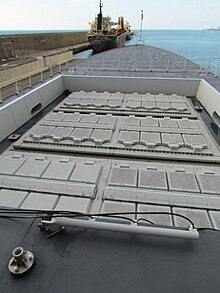
- Sa'ar 5-class corvette – Barak 1 (2 x 32 cells)
- Hyūga-class helicopter destroyer – Mark 41 (16 cells)
- Kongō-class destroyer – Mark 41 (90 cells)
- Atago-class destroyer – Mark 41 (96 cells)
- Maya-class destroyer – Mark 41 (96 cells)
- Murasame-class destroyer – Mark 41 (16 cells) + Mark 48 (16 cells)
- Takanami-class destroyer – Mark 41 (32 cells)
- Akizuki-class destroyer – Mark 41 (32 cells)
- Asahi-class destroyer – Mark 41 (32 cells)
- Mogami-class frigate - Mark 41 (16 cells)
- Asuka - Mark 41 (8 cells)
- Lekiu-class frigate - GWS.26 (16 cells)
- Mohammed VI – SYLVER A50 (16 cells)
- Anzac-class frigate – GWS.35 (20 cells)
- Khareef-class corvette – VL MICA (12 cells)

- Valour-class frigate – Umkhonto 16 cells)
 Russia
Russia- Surface
- Kuznetsov-class aircraft carrier – Granit (12 cells) + Kinzhal (192 cells)
- Kirov-class battlecruiser – Granit (20 cells) + Fort/Fort-M (96 cells) + Kinzhal (128 cells)
- Slava-class cruiser – Fort (64 cells)
- Udaloy-class destroyer – Kinzhal (64 cells)
- Neustrashimyy-class frigate – Kinzhal (32 cells)
- Admiral Grigorovich-class frigate – for Kalibr or BrahMos (8 cells) + for 9M317M (24 cells)
- Admiral Gorshkov-class frigate – 3S14 for Kalibr or Oniks (16 cells) + Redut system for different type of missiles (32 cells)
- Gepard-class frigate – 3S14 for Kalibr or Oniks (8 cells)
- Steregushchy-class corvette – Redut (12 cells)
- Gremyashchy-class corvette – Redut (2 x 8 cells) + 3S14 for Kalibr or Oniks ( 8 cells)
- Buyan-M-class corvette – 3S14 for Kalibr or Oniks (8 cells)
- Karakurt-class corvette – 3S14 for Kalibr or Oniks (8 cells)
- Project 22160E patrol ship – 3S14 for Kalibr or Oniks (8 cells)[7]
- Korsar escort ship – 3S14 for Kalibr (8 cells)[8]
- Submarine
- Amur 950 – 3S14 for Kalibr or BrahMos (10 cells)[9]
- Oscar-class submarine – Granit (24 cells) + RPK-2 Vyuga (28 cells)
- Yasen-M – 3S14 for Kalibr (40 cells) or Oniks (32 cells)[10]
- Typhoon-class submarine – R-39 Rif (20 cells)[11]
- Delta III-class submarine – R-29 Vysota (16 cells)[12]
- Delta IV-class submarine – R-29RMU Sineva or R-29RM Shtil (16 cells)[13]
- Borei-class submarine – RSM-56 Bulava (16 cells)[14]
- Formidable-class frigate – SYLVER (32 cells)
- Victory-class corvette – Barak 1 (2 x 8 cells)
 South Korea
South Korea- Surface
- Gwanggaeto the Great-class destroyer (KDX-I) – Mark 48 (16 cells)
- Chungmugong Yi Sun-shin-class destroyer (KDX-II) – Mark 41 (32 cells) + Korean Vertical Launching System (K-VLS) (24 cells / 32 cells)
- Sejong the Great-class destroyer (KDX-III) – Mark 41 (80 cells) + K-VLS (48 cells)
- Nampo-class minelayer – K-VLS (4 cells)
- Cheon Wang Bong-class LST – K-VLS (4 cells)
- Daegu-class frigate – K-VLS (16 cells)
- Submarine
- Dosan Ahn Changho-class submarine – K-VLS (10 cells)
- Naresuan-class frigate – Mark 41 (8 cells)
- Bhumibol Adulyadej-class frigate ��� Mark 41 (8 cells)
See also[]
- List of United States Navy Guided Missile Launching Systems
- XM501 Non-Line-of-Sight Launch System An Experimental Small Land and Surface VLS
References[]
- ^ Preview ofTable of contents (2016-07-08). "Naval Swiss Army Knife: MK 41 Vertical Missile Launch Systems (VLS)". Defenseindustrydaily.com. Archived from the original on 2016-12-30. Retrieved 2016-12-29.
- ^ "Shots of cold and hot launches of 052D destroyer unveiled". China-arms. 19 February 2020.
- ^ "China Reveals Universal Ship-borne Vertical Missile Launch System". defense post. 1 October 2021.
- ^ Joe, Rick (8 June 2018). "All You Need to Know About China's New Stealth Destroyer". The Diplomat. Archived from the original on 13 June 2018. Retrieved 13 June 2018.
- ^ "Patent US7540227 – Air based vertical launch ballistic missile defense – Google Patents". 2003-05-06. Archived from the original on 2016-12-30. Retrieved 2016-12-29.
- ^ a b c d e f g h i j k l m n o Stöhs, Jeremy. "How High? The Future of European Naval Power and the High-End Challenge" (PDF). Centre for Military Studies. Djøf Publishing. Retrieved 12 September 2021.
- ^ "Patrol ship for distant sea areas Project 22160E | Catalog Rosoboronexport".
- ^ "Project 11541 "Korsar"".
- ^ "ЦКБ МТ Рубин: Amur 950".
- ^ "Russia's newest submarines are 'on par with ours' and sailing closer to the US, top commanders say".
- ^ "SSBN Typhoon Class (Type 941)".
- ^ "Delta III Class Ballistic Missile Submarine | Military-Today.com".
- ^ "Explainer: Russia's Delta IV Nuclear Missile Submarines". 23 December 2020.
- ^ "SSBN Borei Class Nuclear-Powered Submarines - Naval Technology".
External links[]
| Wikimedia Commons has media related to Vertical launching systems. |
- Mk 41 VLS – Federation of American Scientists
- MK 41 Vertical Launching System (VLS) – GlobalSecurity.org
- Mk-48 Vertical Launching System (VLS) – Seaforces-online Naval Information
- Missile launchers
- Missile operation
- Guided missiles
- Missiles
- Rockets and missiles
- Naval weapons
- Soviet inventions
- Russian inventions
